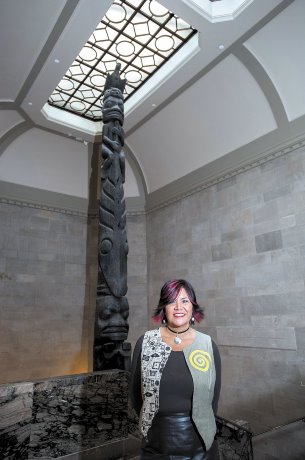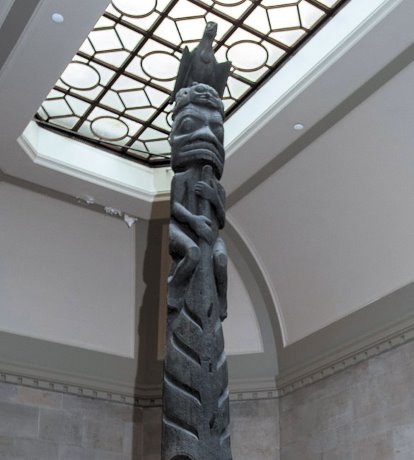Visitors to Toronto’s Royal Ontario Museum (ROM) often wonder how its four famous totem poles were installed inside the intricate stairways of the building. The answer is simple — the building was built around the poles, a validation of their value to the museum.
sga’a and Haida Crest Poles and features four totem poles hand-carved from western red cedar by the Nisga’a people and Haida people of British Columbia’s coast. Among the figures carved on the poles: a horned owl, eagle, killer whale, shark, bear and beaver. The 25-metre Pole of Sagaween is the tallest of the four, carved by Oyee.
Among the ROM’s most treasured artifacts, the poles are treated with reverence.
"When I was going to get my first official photograph taken, I wanted one of the poles as my background," says J’net Ayayqwayaksheelth, indigenous outreach and learning co-ordinator with the ROM. "They said I needed permission, but because I was a west coaster there was no glitch."
The poles were purchased and transported from British Columbia under the instruction of Charles Currelly, the ROM’s first director, in the 1920s during the Potlatch Ban. Under federal legislation, indigenous ceremonies were illegal and production of traditional artwork was discouraged.
"Currelly was blown away by West Coast art," Ayayqwayaksheelth says. "While these artifacts were populating museums around the world, the province of B.C. had no interest in its own indigenous arts. Currelly rationalized that because the poles would not last in nature for another 100 years, that was all the more reason to get them indoors."
The poles were saturated in petroleum and then wax to preserve them and the tallest was cut in half to transport them by train to Toronto. Unfortunately, the oil treatment destroyed the original paint decorations, which had to be reapplied.
The poles were not placed on display until after a ROM expansion in 1933.
"They brought the largest pole in pieces and connected it underneath the skylight before the staircase was wrapped around it," says Ayayqwayaksheelth. "It was very elaborate construction."
West Coast carvers began the process of creating a totem pole by selecting a tree with the fewest branches, giving thanks to the tree, then felling it and removing the bark. Following contact with Europeans, the poles became taller with the advent of iron tools that could more easily fell bigger trees.
"Crest pole artists say that they let the pole tell them what to carve," says Ayayqwayaksheelth. "They work with the grain of the wood and if they see the image of an animal or a knot that reminds them of an eye, they take their inspiration from it to tell a story."
The poles were carved horizontally employing an adz — an axe-like tool used to dress timber. Carving tools for intricate work were made with blades made of jade, flint, metal and crystal or durable ocean mussel shells. Paints made from natural materials would then be applied to the carved surface. The base of a finished pole would be buried underground and the pole would then be erected with the use of cedar ropes.
A more recent revival of potlatch ceremonies has also accompanied a renewed interest in carving.
"A few years ago I was honoured to see a totem pole presented at a memorial potlatch for George Watts in Port Alberni," says Ayayqwayaksheelth. "It was a ceremony that hadn’t been performed in 100 years. It was one of the coolest things I’ve seen."
However, Ayayqwayaksheelth notes indigenous people have mixed feelings about preserving the poles. Some accept the notion that individual works of art will disintegrate and return to nature — it’s the artistic tradition and the reproduction of the art form that many want to see kept alive.
"On the other hand, museums have played an important role in preserving objects for the unborn, celebrating the work of the ancestors that came from living cultures and carrying the stories and knowledge forward," she says. "It talks about the resilience of those cultures. Carving masters are now incorporating what they’ve learned from these exhibits."

J’net Ayayqwayaksheelth, indigenous outreach and learning co-ordinator with the Royal Ontario Museum (ROM), stands in front of one of the four totem poles that rest inside the stairways of the building. The totem poles were purchased and transported from British Columbia under the instruction of Charles Currelly, the ROM’s first director, in the 1920s.
Photo: Royal Ontario Museum"


Recent Comments
comments for this post are closed